Vietnamese cuisine is renowned for its vibrant flavors, exotic ingredients, and delectable desserts. Among the multitude of tantalizing treats, one dessert that stands out for its unique combination of flavors and textures is Vietnamese coconut jelly. This delightful delicacy captures the essence of Vietnam’s culinary heritage and showcases the harmonious blend of sweet and creamy coconut with a refreshing bite of jelly.
In this comprehensive guide, we will delve into the fascinating world of Vietnamese coconut jelly, exploring its origins, traditional recipes, variations, health benefits, and much more. Join us on this flavorful journey as we unravel the secrets behind this beloved Vietnamese dessert.
What is Vietnamese coconut jelly?
Vietnamese coconut jelly is a popular dessert that originates from Vietnam. It holds cultural significance and is often served during special occasions and celebrations. The main ingredients used in Vietnamese coconut jelly include coconut milk and agar agar, a natural gelling agent derived from seaweed. This delightful delicacy combines the creamy richness of coconut with the bouncy texture of jelly, creating a unique and satisfying dessert experience.
Vietnamese coconut jelly, also known as “Thach Dua” in Vietnamese, has gained popularity both within the country and beyond its borders. This dessert is not only visually appealing with its translucent, jewel-like appearance but also offers a delightful sensory experience with every spoonful. The smooth, velvety coconut milk base is delicately infused with the essence of agar agar, a natural gelling agent derived from seaweed, which gives the jelly its distinct texture and consistency.
Whether enjoyed as a dessert to satisfy a sweet tooth or as a refreshing drink on a warm day, Vietnamese coconut jelly never fails to captivate the taste buds. Its subtle coconut flavor, combined with the light, bouncy jelly, creates a harmonious balance that is both soothing and indulgent. Moreover, Vietnamese coconut jelly holds cultural significance in Vietnam and is often served during special occasions and celebrations.
Vietnamese coconut jelly recipe
Before starting the recipe, agar agar coconut milk recipe, ensure that you have a jelly mold or individual serving dishes for setting the jelly.
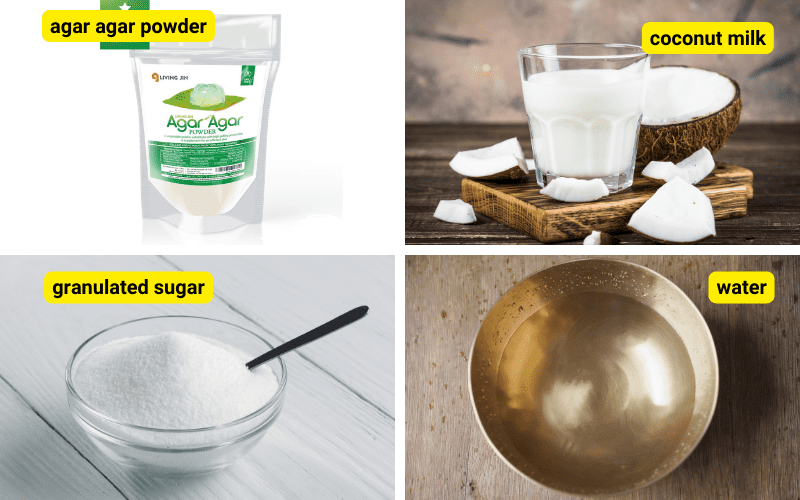
How To Make Vietnamese Coconut Jelly?
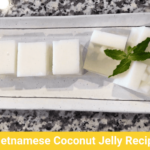
Delight in the unique flavors and textures of Vietnamese coconut jelly, a beloved dessert that combines creamy coconut and refreshing jelly.
- Medium saucepan
- Whisk or spoon for stirring
- Jelly mold or individual serving dishes
- Refrigerator
- 1 packet (7g) agar agar powder
- 400ml coconut milk
- 250ml water
- 150g granulated sugar
- 1/4 teaspoon salt
- 1/2 teaspoon vanilla extract (optional)
- Fresh fruits, for garnish (optional)
Step 1: Preparing the agar agar and coconut milk mixture
In a medium saucepan, combine the agar agar powder, coconut milk, water, sugar, and salt.
Stir the mixture well to dissolve the agar agar powder and sugar.
Place the saucepan over medium heat and bring the mixture to a gentle simmer, stirring continuously.
Continue simmering and stirring for about 5 minutes until the agar agar is completely dissolved and the mixture thickens slightly.
If desired, add vanilla extract for extra flavor and stir to incorporate.
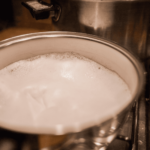
Step 2: Cooking and setting the jelly
Remove the saucepan from heat and pour the mixture into a jelly mold or individual serving dishes.
Allow the jelly to cool at room temperature for about 20 minutes.
Once cooled, cover the jelly mold or dishes with plastic wrap and refrigerate for at least 3-4 hours or until the jelly is fully set.
Step 3: Cooling and serve the dessert
After the jelly has set, remove it from the refrigerator.
If using a jelly mold, gently run a knife along the edges to loosen the jelly. Place a plate upside down on top of the mold and flip it over to release the jelly onto the plate. If using individual dishes, simply serve the jelly in them.
Garnish with fresh fruits, if desired.
Vietnamese coconut jelly can be enjoyed immediately or refrigerated until ready to serve.
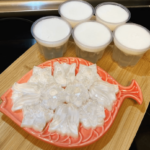
Now you have a delicious batch of Vietnamese coconut jelly ready to be savored and enjoyed!
Nutritional facts and health benefits
Here is the approximate nutritional information for a serving (100g) of Vietnamese coconut jelly calories
| Nutrient | Amount |
| Calories | 120 |
| Total Fat | 8g |
| Saturated Fat | 7g |
| Carbohydrates | 12g |
| Sugar | 8g |
| Protein | 1g |
| Fiber | 0g |
| Sodium | 50mg |
Assessing the nutritional value of key ingredients
- Coconut Milk: Rich in healthy fats and provides essential nutrients like vitamins C, E, and B-complex, as well as minerals such as iron, magnesium, and potassium.
- Agar Agar: Low in calories and a good source of fiber, calcium, and iron.
Health benefits and considerations of consuming Vietnamese coconut jelly
- Healthy Fats: The coconut milk in Vietnamese coconut jelly contains healthy fats that can contribute to satiety and provide energy.
- Nutrient Content: Coconut milk and agar agar offer some essential vitamins, minerals, and fiber, though the exact nutritional profile may vary based on specific brands or homemade recipes.
- Moderation: While Vietnamese coconut jelly can be a delicious treat, it is important to consume it in moderation due to its sugar and saturated fat content.
- Dietary Restrictions: Vietnamese coconut jelly can be suitable for vegetarian and vegan diets, but individuals with allergies to coconut or agar agar should avoid it.
It’s always advisable to check specific brands or homemade recipes for more accurate nutritional information and to consider personal dietary needs and goals.
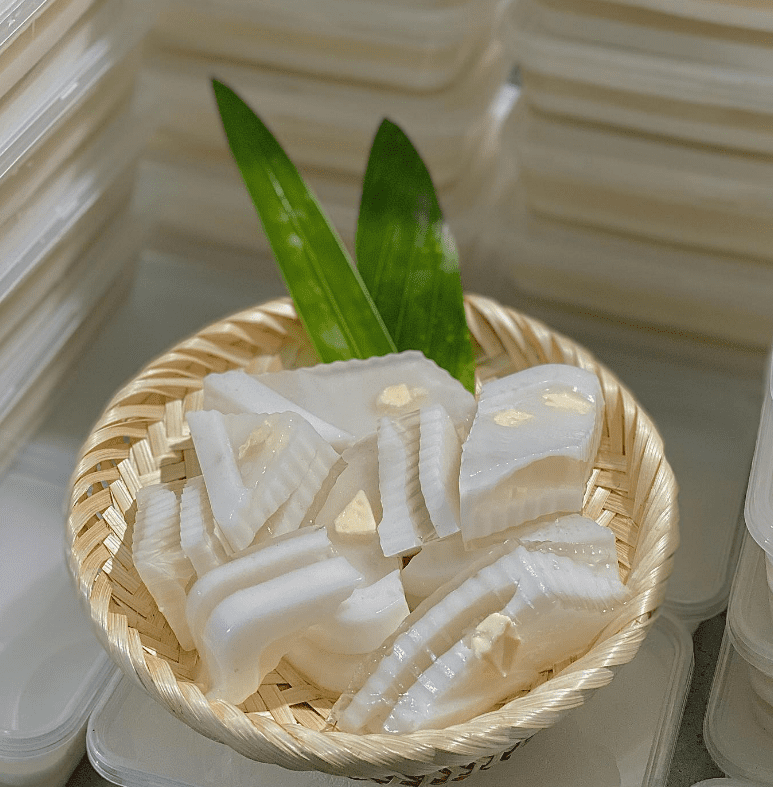
What to serve with Vietnamese coconut jelly?
Vietnamese coconut jelly can be enjoyed on its own as a delightful dessert, but if you’re looking to enhance the experience or add some complementary flavors, here are a few suggestions on what to serve with Vietnamese coconut jelly:
- Fresh Fruits: Serve Vietnamese coconut jelly with a side of fresh fruits such as sliced mangoes, strawberries, lychee, or jackfruit. The juicy and sweet fruits provide a refreshing contrast to the creamy jelly.
- Sweet Sauces or Syrups: Drizzle a bit of sweet sauces or syrups like chocolate sauce, caramel sauce, or fruit coulis over the coconut jelly. The added sweetness and flavors will elevate the dessert.
- Shredded Coconut: Sprinkle some lightly toasted or freshly grated coconut on top of the jelly to enhance the coconut flavor and add a pleasant texture.
- Nuts and Seeds: Consider adding a crunch by serving Vietnamese coconut jelly with a sprinkle of chopped nuts like toasted almonds, cashews, or sesame seeds. It adds a delightful contrast to the soft texture of the jelly.
- Ice Cream: For an indulgent twist, serve a scoop of your favorite ice cream alongside the coconut jelly. The creamy ice cream and the jelly create a delightful combination of textures and flavors.
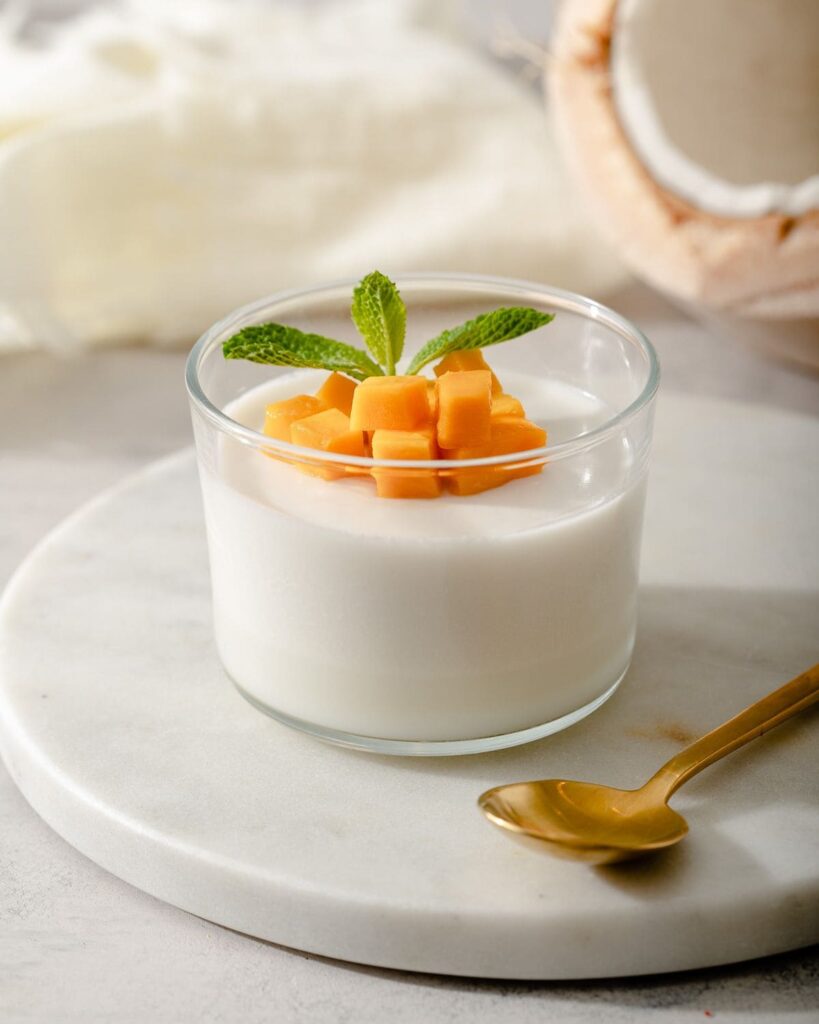
Variations of Vietnamese coconut jelly
These variations allow you to unleash your creativity and personalize the flavors of Vietnamese coconut jelly:
- Pandan-infused Coconut Jelly: Add a touch of pandan flavor by infusing pandan leaves into the coconut milk mixture while cooking the jelly. This variation adds a unique aroma and a vibrant green hue to the jelly.
- Fruit-infused Coconut Jelly: Experiment with different fruits by incorporating fruit puree or juice into the coconut milk mixture. Mango, strawberry, or pineapple puree can add a burst of fruity flavor to the jelly.
- Coffee-infused Coconut Jelly Twist: For coffee lovers, replace a portion of the water in the recipe with brewed coffee. This variation introduces a subtle coffee flavor that pairs well with the creamy coconut.
- Layered Coconut Jelly: Create visually stunning desserts by layering different colored coconut jellies. Prepare multiple batches of coconut jelly with various natural food colorings, allowing each layer to set before adding the next.
- Toppings and Garnishes: Explore various toppings to enhance the texture and flavors of Vietnamese coconut jelly. Consider adding a sprinkle of toasted coconut flakes, chopped nuts, or fresh fruit slices on top of the jelly.
- Vegan-friendly Coconut Jelly: Adjust the recipe to use plant-based milk alternatives, such as almond milk or soy milk, instead of coconut milk. Ensure that the chosen milk substitute has a similar consistency to coconut milk for best results.
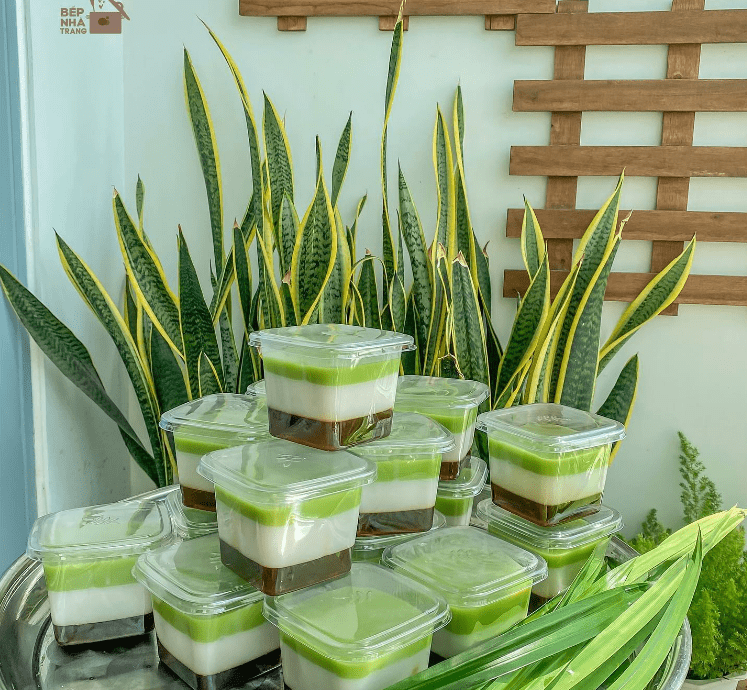
Substitute ingredient of Vietnamese coconut jelly
If you’re looking for a substitute for one of the main ingredients in Vietnamese coconut jelly, here are a couple of options:
- Coconut Milk Substitute: If you don’t have coconut milk or prefer an alternative, you can use other plant-based milk options like almond milk, soy milk, or oat milk. Keep in mind that the flavor and texture of the jelly may differ slightly with the substitute chosen.
- Agar Agar Substitute: If you cannot find agar agar or prefer an alternative gelling agent, you can use gelatin instead. Gelatin is derived from animal collagen and will provide a similar gelling effect. Follow the instructions on the gelatin package for appropriate measurements and preparation.
Note: When substituting ingredients, it’s essential to consider any dietary restrictions, allergies, or personal preferences. Be aware that the flavor and texture of the jelly may vary when using substitutes, so it’s a good idea to experiment and adjust the recipe accordingly to achieve the desired results.
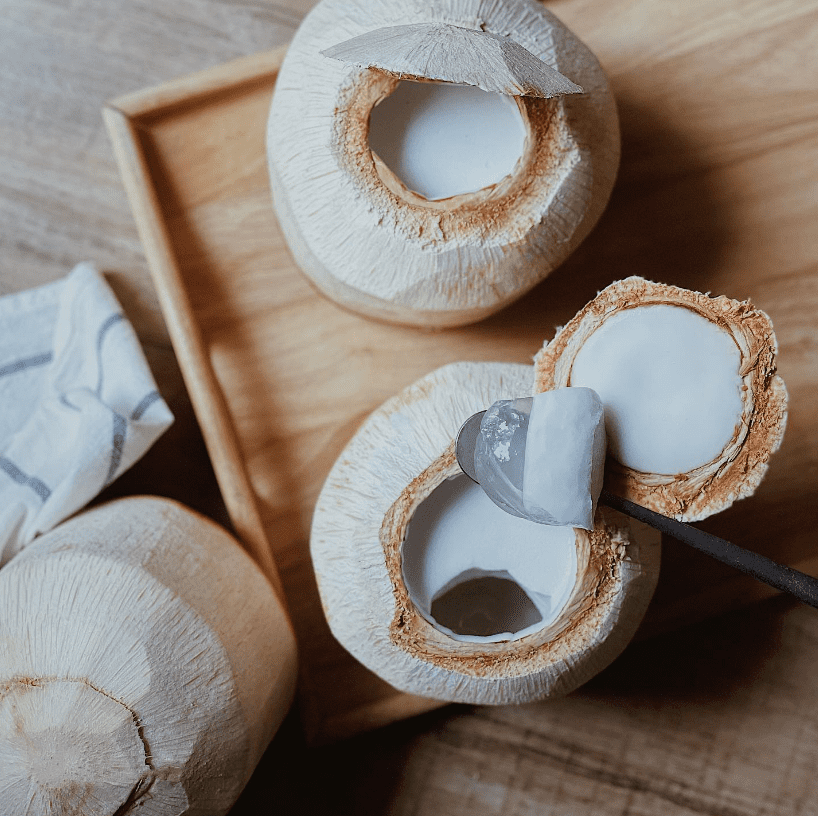
How to store Vietnamese coconut jelly?
To store Vietnamese coconut jelly and maintain its freshness and quality, follow these guidelines:
- Refrigeration: After the jelly has fully set, cover the jelly mold or individual serving dishes tightly with plastic wrap or an airtight lid. Place the jelly in the refrigerator to keep it chilled.
- Proper Storage Container: Use a clean, food-safe container suitable for storing the jelly. Glass or plastic containers with tight-fitting lids work well.
- Avoid Moisture: Ensure the jelly is not exposed to excessive moisture, as it can affect the texture and longevity. Keep the container sealed tightly to prevent any condensation or absorption of moisture.
- Shelf Life: Vietnamese coconut jelly can typically be stored in the refrigerator for 3 to 4 days. However, the specific shelf life may vary depending on the freshness of the ingredients used and any additional toppings or garnishes.
- Separate from Moist Foods: If storing other foods in the refrigerator, try to keep them separate from the jelly to prevent any potential cross-contamination or moisture transfer.
- Best Served Fresh: Vietnamese coconut jelly is best enjoyed fresh. It is recommended to consume it within a few days of preparation for optimal taste and texture.
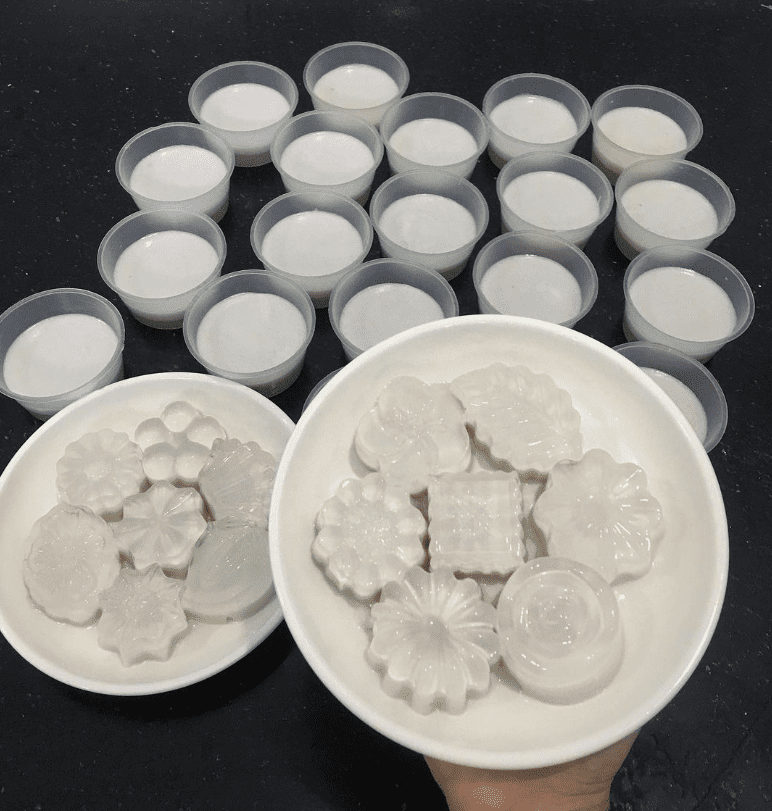
Common mistakes when making Vietnamese coconut jelly
When making Vietnamese coconut jelly, it’s important to be aware of common mistakes to avoid and achieve the best results. Here are some common mistakes to watch out for:
- Insufficient Dissolving: Failing to fully dissolve the agar agar powder or sugar in the coconut milk mixture can result in lumps or an uneven texture in the jelly. Ensure thorough stirring and simmering until all ingredients are dissolved.
- Overcooking the Mixture: Overcooking the coconut milk and agar agar mixture can lead to a firm and rubbery texture. Follow the recommended cooking time and temperature to prevent the jelly from becoming too firm.
- Inadequate Cooling Time: Rushing the cooling process may result in the jelly not setting properly. Allow the mixture to cool at room temperature for around 20 minutes before refrigerating to ensure it sets evenly.
- Not Greasing the Mold: When using a jelly mold, not greasing it before pouring the mixture can make it difficult to remove the jelly later. Grease the mold with a thin layer of cooking oil or use non-stick cooking spray to ease the jelly’s release.
- Premature Unmolding: Trying to unmold the jelly too soon can cause it to break or lose its shape. Make sure the jelly is fully set and firm before attempting to remove it from the mold.
- Lack of Patience: Vietnamese coconut jelly requires adequate setting time in the refrigerator. Trying to serve or slice the jelly before it is fully set can result in a runny or messy texture.
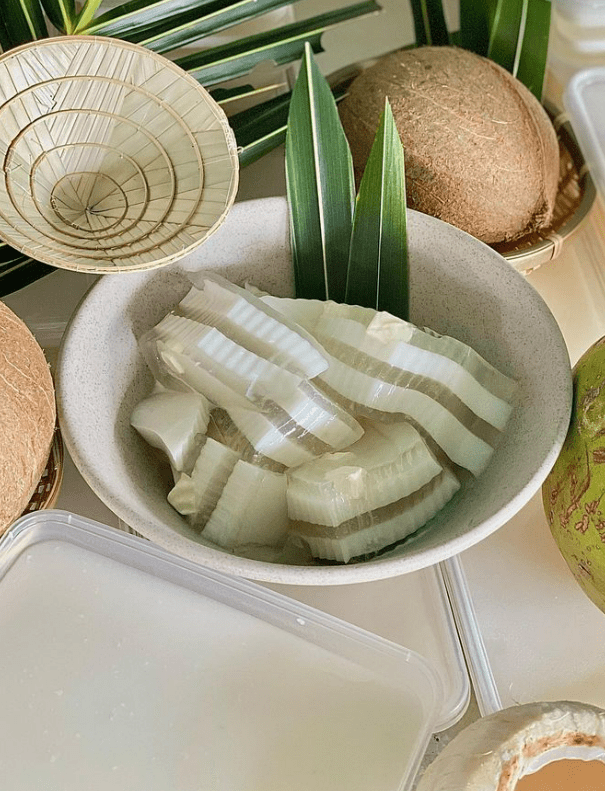
Tips and tricks for perfecting your Vietnamese coconut jelly
To perfect your Vietnamese coconut jelly and achieve the best results, here are some tips and tricks:
- Measure Ingredients Accurately: Ensure precise measurements of agar agar powder, coconut milk, sugar, and other ingredients to maintain the right balance of flavors and textures.
- Use Fresh Ingredients: Opt for fresh coconut milk or high-quality canned coconut milk for the best flavor and consistency.
- Stir Constantly: When cooking the coconut milk and agar agar mixture, stir continuously to prevent the ingredients from sticking to the bottom of the saucepan and ensure even distribution.
- Simmer Gently: Maintain a gentle simmer while cooking the mixture. Avoid boiling it vigorously as it can affect the texture and cause bubbles to form.
- Allow Sufficient Setting Time: Be patient and allow the jelly to fully set in the refrigerator as per the recommended time. This ensures a firm and well-set jelly.
- Test the Mixture: Before pouring the mixture into the mold, you can do a quick test by pouring a small amount into a bowl and refrigerating it for a few minutes. This allows you to check the consistency and adjust the sweetness or flavoring if needed.
- Grease the Mold: If using a jelly mold, lightly grease it with cooking oil or use non-stick cooking spray. This makes it easier to release the jelly from the mold later.
- Presentation: To enhance the visual appeal, consider using decorative molds or adding layers of different colors or flavors for an eye-catching presentation.
- Experiment with Flavors: Feel free to experiment with additional flavors such as pandan, fruit purees, or extracts to add variety and personalize the taste of your coconut jelly.
- Garnish Creatively: Explore various toppings and garnishes like toasted coconut flakes, fresh fruits, or a drizzle of sweet sauces to add texture and visual appeal to your coconut jelly.
FAQs
Is Vietnamese coconut jelly a vegan dessert?
Yes, Vietnamese coconut jelly can be a vegan dessert. The traditional recipe for Vietnamese coconut jelly typically uses ingredients that are plant-based and suitable for a vegan diet. The main ingredients are coconut milk and agar agar, both of which are derived from plant sources.
However, it is essential to ensure that the specific ingredients used, such as canned coconut milk, are labeled as vegan and do not contain any animal-derived additives or sweeteners. Additionally, if you choose to add any toppings or garnishes, make sure they are also vegan-friendly. By using vegan-approved ingredients and following a vegan recipe, Vietnamese coconut jelly can be enjoyed as a delightful vegan dessert option.
Can I use canned coconut milk for Vietnamese coconut jelly?
Yes, you can use canned coconut milk for Vietnamese coconut jelly. It is a convenient option and will provide the creamy and rich coconut flavor that is characteristic of the dessert. Make sure to use unsweetened coconut milk for best results.
Can I use gelatin instead of agar agar for Vietnamese coconut jelly?
Yes, you can use gelatin as a substitute for agar agar in Vietnamese coconut jelly. Gelatin will provide a similar gelling effect and can be used in equal amounts as agar agar. Follow the instructions on the gelatin package for appropriate measurements and preparation.
However, do note that using gelatin will make the dessert non-vegan as gelatin is derived from animal collagen.
How do I prevent the jelly from sticking to the mold?
To prevent the jelly from sticking to the mold, there are a few things you can do:
- Grease the mold: Lightly grease the inside of the jelly mold with a thin layer of cooking oil or use non-stick cooking spray. This will help the jelly release more easily.
- Use silicone molds: Consider using silicone molds, which have a naturally non-stick surface and make it easier to remove the jelly.
- Allow proper setting time: Ensure that the jelly is fully set and firm before attempting to remove it from the mold. This will help it hold its shape better and reduce the chances of sticking.
What is the texture of Vietnamese coconut jelly?
Vietnamese coconut jelly has a soft and bouncy texture. It is firm enough to hold its shape when sliced or scooped but has a delicate and silky smoothness when eaten. The jelly has a pleasant gelatinous consistency that is not overly firm or rubbery. Its texture pairs well with the creamy coconut milk base, creating a delightful contrast that adds to the overall appeal of the dessert.
How can I achieve a vibrant green color in pandan-infused coconut jelly?
To achieve a vibrant green color in pandan-infused coconut jelly, you can follow these steps:
- Obtain fresh pandan leaves: Look for fresh pandan leaves at Asian grocery stores or markets. Frozen pandan leaves can also be used, but fresh leaves typically provide a more intense color.
- Extract the pandan juice: Cut the pandan leaves into small pieces and blend them with water in a blender or food processor. Strain the mixture to extract the vibrant green pandan juice.
- Use pandan juice in the jelly: Substitute a portion of the water or coconut milk with pandan juice in the recipe. Adjust the amount according to your desired level of pandan flavor and color.
What type of coconut milk should I use for the best flavor in the jelly?
For the best flavor in Vietnamese coconut jelly, it is recommended to use full-fat coconut milk. Full-fat coconut milk provides a richer and creamier taste compared to reduced-fat or light versions.
It contributes to the luscious and indulgent flavor that is characteristic of Vietnamese coconut jelly. However, if you prefer a lighter option, you can choose light coconut milk, but keep in mind that it may result in a slightly less creamy texture and milder coconut flavor.
Is Vietnamese coconut jelly suitable for people with nut allergies?
Vietnamese coconut jelly can be suitable for individuals with nut allergies, as the traditional recipe does not typically contain nuts. However, it is important to check the ingredients used, especially if store-bought or if there are any added toppings or garnishes.
Some variations or homemade recipes may incorporate nuts or be processed in facilities that handle nuts, so it is crucial to exercise caution and read labels carefully if you have a nut allergy.
Can I add a layer of fruit jelly to Vietnamese coconut jelly?
Yes, you can add a layer of fruit jelly to Vietnamese coconut jelly to introduce different flavors and textures. After the coconut jelly has partially set, you can gently pour a prepared fruit jelly mixture on top and allow it to fully set before serving. This adds a delightful fruity twist to the dessert.
Ensure that the fruit jelly layer is compatible with the flavors of the coconut jelly and complements the overall taste profile. Experiment with different fruit flavors to create a layered Vietnamese coconut jelly with a burst of fruity goodness.
Conclusion
Last but not least, Vietnamese coconut jelly is a beloved dessert that captures the essence of Vietnamese culinary heritage. With its creamy coconut base and bouncy jelly texture, it offers a delightful and refreshing treat. Whether enjoyed on its own or paired with various toppings and garnishes, Vietnamese coconut jelly never fails to please the palate.
Throughout this comprehensive guide, we have explored the origins, traditional recipes, variations, and health benefits of Vietnamese coconut jelly. From the cultural significance it holds in Vietnam to the creative innovations and flavors that can be explored, this dessert is truly a culinary delight.
Whether you’re savoring it during special occasions, indulging in the vibrant layers of a fruit-infused variation, or relishing the harmony of coconut and agar agar, Vietnamese coconut jelly provides a sensory experience that satisfies both the taste buds and the eyes.
So, take your newfound knowledge and embark on your own journey of creating and enjoying this exquisite dessert. With its unique flavors, versatility, and cultural heritage, Vietnamese coconut jelly is sure to leave a lasting impression and a longing for more. Embrace the delights of Vietnamese coconut jelly and let it transport you to the vibrant culinary world of Vietnam.